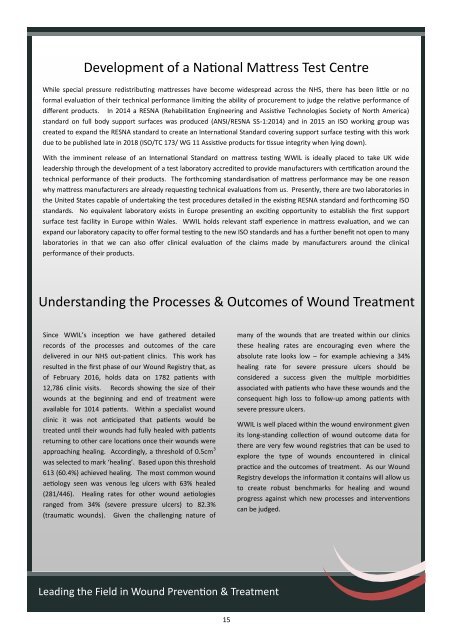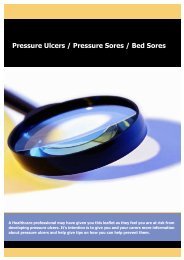Annual Report 2016
Create successful ePaper yourself
Turn your PDF publications into a flip-book with our unique Google optimized e-Paper software.
Development of a National Mattress Test Centre<br />
While special pressure redistributing mattresses have become widespread across the NHS, there has been little or no<br />
formal evaluation of their technical performance limiting the ability of procurement to judge the relative performance of<br />
different products. In 2014 a RESNA (Rehabilitation Engineering and Assistive Technologies Society of North America)<br />
standard on full body support surfaces was produced (ANSI/RESNA SS-1:2014) and in 2015 an ISO working group was<br />
created to expand the RESNA standard to create an International Standard covering support surface testing with this work<br />
due to be published late in 2018 (ISO/TC 173/ WG 11 Assistive products for tissue integrity when lying down).<br />
With the imminent release of an International Standard on mattress testing WWIL is ideally placed to take UK wide<br />
leadership through the development of a test laboratory accredited to provide manufacturers with certification around the<br />
technical performance of their products. The forthcoming standardisation of mattress performance may be one reason<br />
why mattress manufacturers are already requesting technical evaluations from us. Presently, there are two laboratories in<br />
the United States capable of undertaking the test procedures detailed in the existing RESNA standard and forthcoming ISO<br />
standards. No equivalent laboratory exists in Europe presenting an exciting opportunity to establish the first support<br />
surface test facility in Europe within Wales. WWIL holds relevant staff experience in mattress evaluation, and we can<br />
expand our laboratory capacity to offer formal testing to the new ISO standards and has a further benefit not open to many<br />
laboratories in that we can also offer clinical evaluation of the claims made by manufacturers around the clinical<br />
performance of their products.<br />
Understanding the Processes & Outcomes of Wound Treatment<br />
Since WWIL’s inception we have gathered detailed<br />
records of the processes and outcomes of the care<br />
delivered in our NHS out-patient clinics. This work has<br />
resulted in the first phase of our Wound Registry that, as<br />
of February <strong>2016</strong>, holds data on 1782 patients with<br />
12,786 clinic visits. Records showing the size of their<br />
wounds at the beginning and end of treatment were<br />
available for 1014 patients. Within a specialist wound<br />
clinic it was not anticipated that patients would be<br />
treated until their wounds had fully healed with patients<br />
returning to other care locations once their wounds were<br />
approaching healing. Accordingly, a threshold of 0.5cm 3<br />
was selected to mark ‘healing’. Based upon this threshold<br />
613 (60.4%) achieved healing. The most common wound<br />
aetiology seen was venous leg ulcers with 63% healed<br />
(281/446). Healing rates for other wound aetiologies<br />
ranged from 34% (severe pressure ulcers) to 82.3%<br />
(traumatic wounds).<br />
Given the challenging nature of<br />
many of the wounds that are treated within our clinics<br />
these healing rates are encouraging even where the<br />
absolute rate looks low – for example achieving a 34%<br />
healing rate for severe pressure ulcers should be<br />
considered a success given the multiple morbidities<br />
associated with patients who have these wounds and the<br />
consequent high loss to follow-up among patients with<br />
severe pressure ulcers.<br />
WWIL is well placed within the wound environment given<br />
its long-standing collection of wound outcome data for<br />
there are very few wound registries that can be used to<br />
explore the type of wounds encountered in clinical<br />
practice and the outcomes of treatment. As our Wound<br />
Registry develops the information it contains will allow us<br />
to create robust benchmarks for healing and wound<br />
progress against which new processes and interventions<br />
can be judged.<br />
Leading the Field in Wound Prevention & Treatment<br />
15



